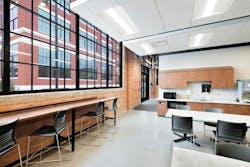Modernizing mental health care in emergency departments: Improving patient outcomes
Emergency Departments frequently handle the intake of patients with mental health care needs.
In today’s mental health crisis, there is a widespread shortage of beds to handle certain populations. Patients may languish in the ED for hours or days before they can be linked to an appropriate inpatient program. This article considers several improvements to the built environment and subsequent care that to support a compassionate and healing environment.
Receive Patients Warmly
One of the biggest barriers to psychiatric care, is the shame and disgrace that can come along with the labels. To destigmatize those needing care, even crisis care, is to treat the incoming patients with dignity. Consider an assessment and ED bed specifically designed to put providers at the same eye-level as patients in a warm and intimate setting.
This also opens up opportunities for mental heath conversations to be had alongside physical ailments. When society starts to see mental health as an essential part of overall health care, these conversations should be part of every medical visit.
Calming Environment
The noise, movement, and energy in an emergency department often exacerbates anxiety, paranoia, and discomfort for patients presenting to the ED with mental health care needs. Making an intentional choice to mitigate this could be committing to an emPATH unit (emergency Psychiatric Assessment, Treatment, and Healing unit). EmPath units generally consist of three components: homey waiting areas with comfortable recliners, a flood of daylight, and calming interior design, and co-mingled care team with eyes on patients, and the ability to respond to needs, and breakout rooms to facilitate prompt assessment by a psychiatrist and subsequent treatment plan.
EmPATH units have risen in popularity and have shown to reduce the stress on the ED and provide mental health patients with a higher level of care for their unique needs. When an emPATH unit is not possible, taking cues from the design may be the next right thing. Interestingly, hospitals with emPATH units find that patients waiting in the common area often find comfort in each other. Distraught feelings that may spiral when in a private room tend to be kept at bay when patients are able to speak with a peer – even exchanging small talk.
Hospitals could consider a separate area for waiting & assessment within the existing ED’s footprint that accommodates sensory needs. Providing a noise-controlled area reduces auditory stimulation and can profoundly support a calming environment. It aids with de-escalation and medical coercion becomes less necessary. Rather than the TV’s playing, consider calming artwork, soft textures, and views to the outside.
Alongside views to the outside, daylight helps balance mood and serves a critical role in a balanced circadian rhythm. Natural light is known to boost moods and reduce sleep disorders. While a room with daylight will not provide the only treatment for mental health crisis, it does trigger stabilizing hormones key to mood recovery.
Positive Distraction
The hours or days from arrival to treatment will be fraught with distress no matter the situation. Providing opportunities for patients or staff to change the environment can distract the patients in a positive manner. Artwork, sculpture, lighting, and interactive touch screens can help reduce stress alongside proper treatment. Lighting can be designed to accomplish this in two ways: color temperature, and color LEDs.
Color temperature: Fixtures can be selected for specific control of the color temperature. The environment can be adjusted to be warmer or cooler. Warm color temperatures mimic incandescent lamps at home. And cooler color temperatures are typical of what we see in offices and retail stores. We would not recommend adjusting the color temperatures too cool, as it gives off a very institutional feel.
Color Changing LEDs: Just like the name says, you can give patients access to select a different color for accent lighting in the room. Based on the patient’s mood, they can choose a different color. These are particularly popular with pediatric patients.
Spaces for Support
Family and community support is an essential component for mental health of humans in general. For those in crisis, then, it’s paramount. Creating spaces for loved ones to accompany psychiatric patients at every step of the way. How do we make it easier for them to stay the hours or days?
Equally important is promoting staff support. With high stress and high stakes, morale can take big dips with an unfortunate outcome, or the continual challenges of caring for underserved populations. Taking a break room to the next level would mean creating space for collaboration, encouraging connection between employees, and a place to disengage with the daily trials to see the big-picture impact. Consider a space dedicated to reminding staff of their impact: thank you letters, accolades, and other big wins.
Most psychiatric crisis can be resolved in less than 24 hours.
Our ED’s have unintentionally become the environment of care for patients in crisis when they are waiting hours or days to be admitted. We must consider how the spaces in the ED can help support mental health recovery. With 1 in 5 Americans facing a mental heath challenge, it’s important to break down the stigma and provide supportive spaces.
About the Author
Rachel Vedder, RA, LEED AP, with a Senior Architect with Design Collaborative. She is a Registered Architect who joined Design Collaborative in 2009. She has managed the design process for numerous significant projects and excels at client service and building consensus with project stakeholders. She understands that an effective project manager must be fully engaged in all activities of the project.
About the Author
Design Collaborative
Design Collaborative is an award-winning multi-disciplinary design firm founded in 1992, with the belief that through our work, we can improve people's worlds. With nationally recognized expertise and a passion for improving worlds, DC has grown to become consistently ranked amongst the top 100 firms in the country by staying focused on designing people-first places. At DC, we provide boutique firm experience with big firm expertise and resources. Our team includes architects, engineers, interior designers, cost estimators, graphic designers, and support staff. We are a one-stop solution, providing real-time collaboration and problem-solving. Follow Design Collaborative on Facebook, Instagram, and LinkedIn.




